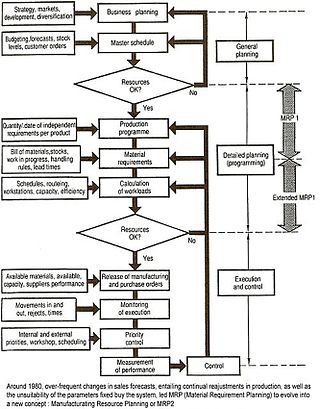Manufacturing resource planning (MRP II) is defined as a method for the effective planning of all resources of a manufacturing company. Ideally, it addresses operational planning in units, financial planning, and has a simulation capability to answer "what-if" questions and extension of closed-loop MRP.
This is not exclusively a software function, but the management of people skills, requiring a dedication to database accuracy, and sufficient computer resources. It is a total company management concept for using human and company resources more productively.
Key functions and features
MRP II is not a proprietary software systems and can thus take many forms. It is almost impossible to visualize an MRP II system that does not use a computer, but an MRP II system can be based on either purchased–licensed or in-house software.
Almost every MRP II system is modular in construction. Characteristic basic modules in an MRP II system are:
- Master production schedule (MPS)
- Item master data (technical data)
- Bill of materials (BOM) (technical data)
- Production resources data (manufacturing technical data)
- Inventories and orders (inventory control)
- Purchasing management
- Material requirements planning (MRP)
- Shop floor control (SFC)
- Capacity planning or capacity requirements planning (CRP)
- Standard costing (cost control) and frequently also Actual or FIFO costing, and Weighted Average costing.
- Cost reporting / management (cost control)
together with auxiliary systems such as:
- Business planning
- Lot traceability
- Contract management
- Tool management
- Engineering change control
- Configuration management
- Shop floor data collection
- Sales analysis and forecasting
- Finite capacity scheduling (FCS)
and related systems such as:
- General ledger
- Accounts payable (purchase ledger)
- Accounts receivable (sales ledger)
- Sales order management
- Distribution resource planning (DRP)
- Automated warehouse management
- Project management
- Technical records
- Estimating
- Computer-aided design/computer-aided manufacturing (CAD/CAM)
- CAPP
The MRP II system integrates these modules together so that they use common data and freely exchange information, in a model of how a manufacturing enterprise should and can operate. The MRP II approach is therefore very different from the "point solution" approach, where individual systems are deployed to help a company plan, control or manage a specific activity. MRP II is by definition fully integrated or at least fully interfaced.
Benefits[edit]
MRP II systems can provide:
- Better control of inventories
- Improved scheduling
- Productive relationships with suppliers
For design / engineering:
- Improved design control
- Better quality and quality control
For financial and costing:
- Reduced working capital for inventory
- Improved cash flow through quicker deliveries
- Accurate inventory records
